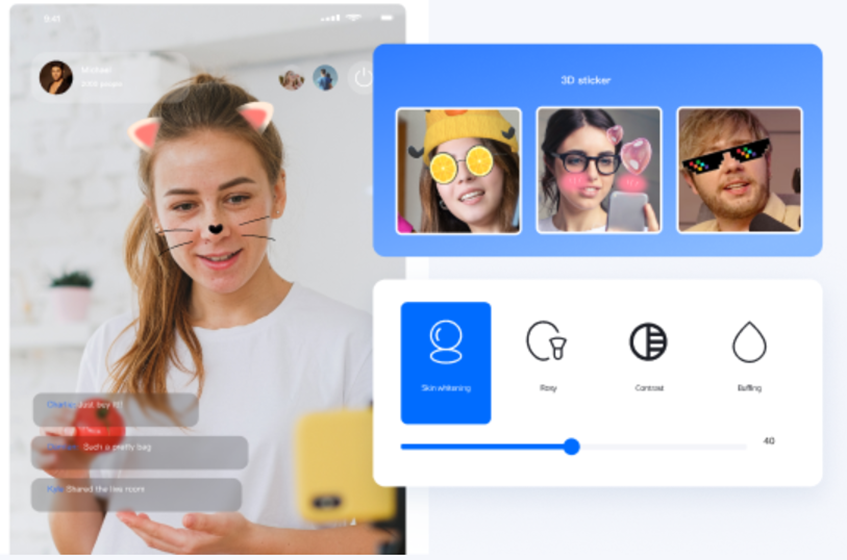
Augmented Reality (AR) face filters have revolutionized digital interaction by offering dynamic and engaging experiences for users across multiple platforms. In 2025, these digital overlays have become more than just playful elements; they are essential components across multiple industries. With facial recognition technology and AI becoming more sophisticated, AR face filters capture the imagination by allowing unique expressions and creativity. Apps and platforms have integrated AR features to enhance user engagement, altering how people perceive and interact with the digital world. The surge of AR face filters is redefining consumer expectations, providing personalized experiences that resonate on both a personal and commercial level, while also paving the way for a future where digital interaction is increasingly immersive.
The Evolution of AR Face Filters
From Fun Overlays to Essential Tools
Initially, AR face filters were novelties used mainly in social media to add a layer of fun to selfies and videos. Over time, these filters evolved into vital tools that drive engagement, marketing strategies, and innovation across various sectors. Brands capitalize on this technology, utilizing it for marketing campaigns and product showcases, turning casual users into loyal customers who appreciate interactive experiences tailored specifically for them. Now, filters have developed into key tools that allow businesses to forge deeper connections with their audiences, reinforcing brand identity and consumer loyalty while driving creative digital marketing trends.
Technological Advancements Driving Adoption
The technology behind AR face filters has advanced significantly, making them more realistic, responsive, and widely adopted by users. Enhanced computing power and improved facial recognition algorithms allow filters to seamlessly blend with natural features, offering users more lifelike and captivating interactions. The integration of BytePlus Effects exemplifies how intricate three-dimensional effects and real-time processing power are transforming AR applications, paving the way for personalized, immersive interactions that align with user or brand identity. Additionally, improvements in AI-driven personalization now allow these filters to adapt to specific user behaviors, creating an even more dynamic experience.
Key Drivers Behind the 2025 Surge
Integration with Social Media Platforms
Social media platforms enhance user interaction by integrating AR face filters deeply into their ecosystems. Starting as engagement tools, they are now core to user identity and platforms’ visual communication strategies. Facebook, Instagram, and Snapchat deploy AR filters that enhance user content, making posts more appealing and shareable. This integration promotes creative expression, as users experiment with filters reflecting their personality, cultural influences, and mood. Through seamless integration, these platforms continue to shape the ways people communicate digitally, blurring the lines between personal and digital personas in the process.
Enhanced User Engagement and Personalization
AR technology facilitates heightened user engagement by providing tailor-made experiences that directly cater to individual preferences. Users enjoy trying different looks and alter their digital appearances without commitment, which fosters prolonged interaction with digital platforms. The use of BytePlus Effects further enhances this by offering versatile tools for customized filters that adapt to each user’s preferences, delivering a unique, engaging, and personalized digital journey. This personalization helps strengthen connections with the platforms, encouraging continued usage, deeper user loyalty, and facilitating a more immersive online experience.
Impact on Industries and Consumer Behavior
Revolutionizing Online Shopping Experiences
AR face filters radically transform online shopping by providing a tactile, interactive experience in a digital environment. Retailers adopt AR technology to allow customers to virtually try on products before purchasing, reducing returns and increasing satisfaction. BytePlus Effects empowers retailers to develop tailored solutions with realistic interactions, enabling shoppers to visualize products directly on their faces or bodies, enhancing decision-making and aligning with consumer expectations. This shift in shopping experiences is revolutionizing how customers interact with digital marketplaces, making e-commerce more intuitive and enjoyable than ever before.
Influencing Beauty Standards and Self-Perception
AR face filters influence beauty standards by allowing individuals to explore a wide range of appearances, often enhancing and altering features in fascinating ways. This digital self-exploration encourages new norms of beauty that are technology-driven and diverse, fostering inclusivity in the beauty landscape. Despite the potential for enhancing individual expression, there’s an ongoing dialogue about the impact on self-perception. The empowerment to display altered versions of oneself can inspire confidence but also raises questions about realism and authenticity in digital representation, prompting deeper reflections on what it means to be “real” in an increasingly digital world.

Conclusion
In 2025, AR face filters dominate digital landscapes, transforming interaction and commerce. Their integration into social media and retail has resulted in unprecedented user engagement and industry innovation. As these technologies evolve, they will continue to shape consumer behavior, offering personalized experiences that challenge traditional boundaries and redefine digital identities. Understanding the implications of this technology will be crucial as it continues to blend into daily digital activities, impacting everything from social media trends to global commerce, and reshaping how we engage with the world around us.